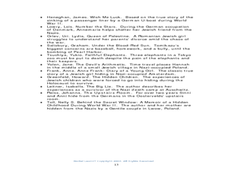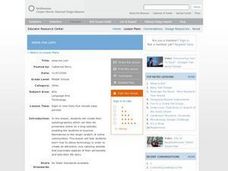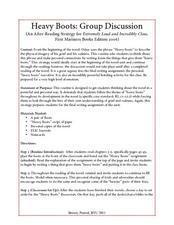Curated OER
Use of Personification and Imagery in Poetry
A reading of Theodore Roethke’s dark "Root Cellar" and Sylvia Plath’s more abstract "Mirror" launches a discussion of imagery and personification in poetry. After finding examples of personification in the poems, class members craft...
Alabama Learning Exchange
Presenting the Water Cycle
Third graders complete a unit of study about the water cycle using both print and Internet based resources. They examine fresh and salt water and complete an online quiz before developing a multimedia presentation highlighting the phases...
Alabama Learning Exchange
Levers - Weight Lifters
Students investigate how levers help to lift heavy loads. They view and discuss examples of levers, explore various websites, experiment with the levers brought to the class, and watch the video for the book "Mike Mulligan and His Steam...
Curated OER
Sharing Our Strengths
In this activity, students appreciate their own unique talents-and that of others-by presenting an interest, talent, or hobby.
Curated OER
Cross-Cultural Dialogue Lesson
Students view situations from more than their own point of view. They use the incidents in the author's story to explore the concept of crossing cultures and reflect on what it is like to feel like an outsider (in the way that the author...
Curated OER
Digital Storytelling Lesson Plans Bring Stories to Life
Students can use technology to enhance and improve their stories using digital storytelling lesson plans.
Curated OER
A Disaster in the Making
Students compare the consequences of the 1906 earthquake in San Francisco to Hurricane Katrina's impact on New Orleans as a basis for investigating the transformative effect of infamous United States natural disasters.
Curated OER
A Ticket to Japan
Fourth graders discover similarities and differences in the lifestyles and geography of Utah and Japan. They use a Venn Diagram to compare and contrast daily life and geography in Utah with daily life and geography in Japan. They make...
Curated OER
The Children of World War II
Students examine the lives of children during WWII. In this WWII lesson, students investigate the effects of the war on children, what life was like on and off the battlefield and how the geography influenced decisions. Students also...
Curated OER
Sequencing
High schoolers consider how cause and effect translate into sequencing in literary works. In this sequencing lesson, students read non-fiction passages about Eleanor Roosevelt and Clara Barton. High schoolers complete graphic organizers...
Curated OER
The Magic Mountain by Thomas Mann
In this online interactive reading comprehension worksheet, students respond to 15 multiple choice questions about Mann's The Magic Mountain. Students may submit their answers to be scored.
Curated OER
Creating a Pot: Repetition as a Unifying Design Element
Students use subjects, themes, and symbols that demonstrate knowledge of contexts, values, and aesthetics that communicate intended meaning in artworks.
Curated OER
www.Me.Com
Create a graphic autobiography integrating images and text. Working within the structure of the programs Comic Life and Photoshop, pupils integrate the Principles of Design. They focus on balance, rhythm, proportion, and text structure....
Curated OER
Character Traits: Yang the Youngest and His Terrible Ear
Lensey Namioka’s Yang the Youngest and His Terrible Ear provides an opportunity for young readers to observe how writers bring their characters to life. Each class member selects a character to trace through the novel, recording...
Curated OER
The Summer of the Swans
The Summer of the Swans, by Betsy Byars, is a 160-page chapter book about a family going through a difficult time. Complement your reading of Byars' book with this detailed outline of each chapter. Every section includes comprehension...
Curated OER
Scripting the Past: Exploring Women's History Through Film
Explore women's history through films and filmmaking. An innovative research project prompts class members to create their own screenplay about a figure in women's history. After outlining their characters, settings, and plots, young...
Premier Literacy
Point of View
Incorporate technology into a literature activity with an innovative language arts activity. Middle schoolers read an electronic version of original stories or fairy tales, and after determining the point of view, rewrite the tale from a...
Curated OER
Heavy Boots: Group Discussion
Jonathan Safran Foer's phrase, "heavy boots," becomes the focus of a class discussion of grief and sadness. During the reading of Extremely Loud and Incredibly Close, individuals place examples of their own experiences with these topics...
National Endowment for the Arts
Reader Resources: The Great Gatsby by F. Scott Fitzgerald
A handy guide offers high schoolers support as they read the American novel, The Great Gatsby. Complete with a biography of F. Scott Fitzgerald, a timeline of the Roaring Twenties, discussion questions about the novel, and more, this...
Shoop English
Literature Terms Activity
Designed to be used with an independent reading book, this activity provides practice with identifying and explaining literary terms. While they read, individuals find instances of literary devices and elements in use in their books....
Museum of Tolerance
Artifact Research Activity
Artifacts give us the privilege of learning about the past, may it be family, culture, or traditions. Here, class members learn about their family's past with the help of an artifact, or family heirloom. Once an artifact is discovered,...
Curated OER
Cheerful Hearts and Willing Feet
Students explore characterization in Little Women. In this literature lesson, students participate in written analysis and research in order to explore Alcott's characterization in the novel.
Curated OER
Sondheim: Voice of Cultural Change
High schoolers explore Stephen Sondheim's contributions to musical theatre in the context of the dramatic cultural shift that occurred in American life in the late 1950s, 1960s, and 1970s.
Curated OER
Objectivity
Help young readers examine historic artifacts to determine if they were designed to help people survive or to create enjoyment. They identify objects that were designed to help people to survive and to enjoy themselves. Then compare and...























